| th |
thirsty,
think,
thumb,
thought,
thatch,
three,
thousand,
thick,
thin, healthy, author,
method, worthless, arithmetic, earth, bath, month, mouth,
tooth |
|
|
|
Note: the red
letters all have the same sound |
|
|
|
Sound Type
This is an UNVOICED sound which means Your Vocal Cords DO
NOT vibrate when making the sound. |
 You CANNOT
LISTEN to your Vocal Cords vibrating if you cover
your ears with your hands. You CANNOT
LISTEN to your Vocal Cords vibrating if you cover
your ears with your hands.
Try covering your ears with your hands as Akiko is doing in
the picture.
Now make the sound of this lesson. You cannot listen to your vocal cords vibrating.
VERY GOOD |
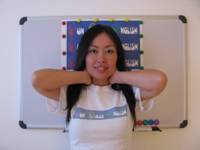 You
CANNOT FEEL your Vocal Cords vibrating if you place your hands on
your neck. You
CANNOT FEEL your Vocal Cords vibrating if you place your hands on
your neck.
Try placing your hands on your neck as Akiko is doing in the
picture.
Now make the sound of this lesson. You cannot feel your
vocal cords vibrating.
VERY GOOD |
|
The following diagram shows the most important parts of your
head and mouth used for pronouncing the sounds of English.
It also shows the location of your Vocal Cords. |
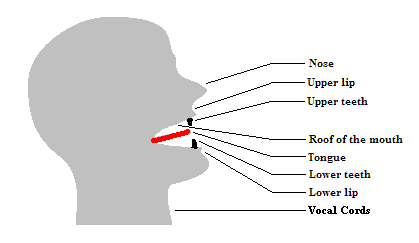 |
|
|
Mouth, lips,
and tongue position
The following descriptions explain the proper mouth, lips,
and tongue position when you make this sound. |
Your mouth releases air continuously. |
Your lips should be slightly separated. |
The front part of your tongue should be between your upper teeth and your lower teeth. |
|
|
Additional Lessons |
 About These
Lessons About These
Lessons
The following classroom lessons are great for students
who want additional listening and reading practice. |
-
Travel America -
Beginner
Level. Do you love America and American
English? Learn before you travel. Facts and other
cool stuff about your favorite U.S. state. Great
English reading practice.
|
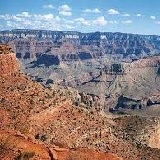 Travel
America - Wisconsin Travel
America - Wisconsin
(Beginner -
Reading)
Learn some interesting facts and read interesting
stories about Wisconsin. |
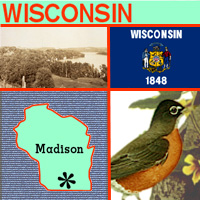 Wisconsin Wisconsin
In 1634, Frenchman Jean Nicolet became Wisconsin's
first European explorer. The French controlled the
area until 1763, when it was ceded to the British.
The state's name is an English version of a French
adaptation of an Indian name said to mean "the place
where we live." The Wisconsin Territory was formed
in 1836 and was admitted into the Union as the 30th
state in 1848. With the nickname "America's
Dairyland," it's no surprise that Wisconsin is one
of the top producers of milk, cheese, and butter in
the country. In fact, the loyal fans of the Green
Bay Packers football team call themselves "cheeseheads."
Milwaukee, the state's largest city, helps make
Wisconsin one of the largest manufacturing states in
the nation. The state capital, Madison, is home to
the University of Wisconsin. The flower of the
"Badger State" is the wood violet and the state bird
is the robin. |
Wisconsin
State Flag
The Wisconsin state flag features the state coat of
arms on both sides against a field of blue, with the the
state name; "WISCONSIN" above and "1848" below (the year
Wisconsin was admitted to the Union). The coat of arms,
which includes the state motto, is also used on Wisconsin's
state seal. |
|
Source:
State Symbols USA |
|
|
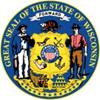 Wisconsin
State Facts Wisconsin
State Facts
Picture: state seal of Wisconsin |
|
State Capital |
Madison |
|
Nickname |
Badger State / America's Dairyland |
|
Motto |
Forward |
|
Statehood |
May 29, 1848 (30th) |
|
Origin of Name |
Based on an Indian word "Ouisconsin" believed to
mean "grassy place" in the Chippewa tongue |
|
Largest Cities |
Milwaukee, Madison, Green Bay, Kenosha, Racine |
|
Border States |
Illinois, Iowa, Michigan, Minnesota |
|
Area |
54,314 sq.mi., 25th largest |
|
State Bird |
Robin |
|
State Flower |
Wood Violet (viola papilionacea) |
|
State Tree |
Sugar Maple (acer saccharum) |
|
State Song |
On Wisconsin |
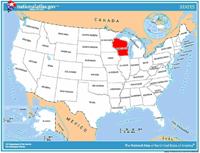 Travel and tourism
site for Wisconsin - This state travel and territorial
tourism site provides ideas for your vacations, meetings, and more. Travel and tourism
site for Wisconsin - This state travel and territorial
tourism site provides ideas for your vacations, meetings, and more. |
|
|
Wisconsin Stories |
|
|
Experimental Aircraft Association's
AirVenture
Have you ever wanted to fly a plane?
If you want to learn about flying a plane, how to make one, or if
you just enjoy being around airplanes, come to the Experimental
Aircraft Association's AirVenture Show in Oshkosh, Wisconsin. You'll
be able to see daredevils like the man on the airplane. A group of
people interested in building their own airplanes started the
Experimental Aircraft Association (EAA) in 1953 and organized an air
show. Over the years, the organization expanded its mission to
include antiques, helicopters and other types of planes.
At the AirVenture Show visitors can see planes up close -- an old
plane like the Spirit of St. Louis (the first plane to fly with a
solo pilot nonstop across the Atlantic), a Stealth fighter or maybe
even the supersonic Concorde. If you want to learn about flying,
check out the Young Eagles. The goal of the Young Eagles Pilot
Program is to give 1 million people ages 8 to 17 a free introductory
airplane ride. These rides are provided through the generosity of
volunteer EAA pilots. If you'd like to be a pilot some day, you've
found the right place! |
|
|
The Wisconsin Dells
Have you ever heard of a dell?
The Wisconsin Dells are dramatic rock formations found along the
Wisconsin River. They were shaped by strong currents of water from
melting glaciers. About 500 million years ago, this area was a lot
different than it looks today. It used to be covered by shallow
seas. For about 80 million years the seas flowed back and forth over
the land, leaving sand on the sea bottom. Over time, the sand kept
building up until it rose above the seas. The huge sand formations
that rose out of the water are the tall sandstone cliffs you see
today in the Wisconsin Dells. These unique cliffs can be found in
only three other areas in the world, Switzerland, Germany and parts
of New York.
The Wisconsin Dells got their name from the French term "dalles." It
means "slab-like rock." Some of the more distinctive rock formations
are named for objects they resemble, such as Chimney Rock. During
the 1800s, the Dells grew to be a popular tourist attraction in
Wisconsin. Visitors still enjoy exploring the area's caves and
arches. |
|
|
Harley-Davidson: "Coming Home"
Have you ever seen someone ride a hog? No, not a pig, a
Harley-Davidson motorcycle!
In 1903, this little one-room building was the birthplace of the
world's most famous motorcycle company -- Harley-Davidson. On its
95th anniversary in 1998, more than 100,000 Harley-Davidson fans
gathered in Milwaukee to celebrate. Many riders took part in five
fund-raising rides, which left from Spokane, Washington; Riverside,
California; Dallas, Texas; Orlando, Florida; and York, Pennsylvania.
They left on June 3, 1998, and arrived in Milwaukee 10 days later.
Along the way they held fundraising events for the Muscular
Dystrophy Association.
Harley-Davidson is the premier American-based manufacturer of
heavyweight motorcycles. In 1903 the company built only three
motorcycles, but 10 years later, it built more than 12,000 a year.
In 1995, Harley-Davidson built 105,104 motorcycles. Harley-Davidson
motorcycles are also called "hogs." One possible explanation for
this dates back to the 1920s when the Harley-Davidson factory had a
racing team that brought their mascot with them to every race. Their
mascot was a pig. So whenever the Harley-Davidson team came to a
race people would say, "Here comes the Harley team and their hogs." |
|
|
The Circus Parade (Circus World Museum)
Isn't the circus wagon in the photo beautiful? It dates from 1935
and it is part of the Circus Parade in Milwaukee, Wisconsin.
Every year in July more than 100 clowns, 1,000 musicians, 700 horses
and lots of animals, including elephants and camels, take part in a
re-creation of a circus street parade from the beginning of the 20th
century. Before the days of radio and television, "Circus Day" was a
time to escape the normal routine and enjoy the entertainment
provided by the traveling performers.
The historic circus wagons have elaborate woodcarvings, mirrored
surfaces, and colorful wheels. These wagons are brought on the Great
Circus Train from the Circus World Museum in Baraboo, Wisconsin,
which has a collection of more than 150 wagons. At one time
Wisconsin was known as the "Mother of Circuses," and was the home or
winter quarters for more than 100 traveling tent shows.
Today, the parade route starts near the shores of Lake Michigan. It
winds its way through the streets of downtown Milwaukee. But a few
changes must be made along the route. The open metal gratings on
Milwaukee's bridges have to be covered so the animals won't be
afraid to cross. And the oxen refuse to step on manhole covers.
Don't ask why. No one knows. |
|
Source:
Library of Congress |
|
 National
Forests of Wisconsin National
Forests of Wisconsin
The following is a description of national
forests in the state
of Wisconsin. There are no national parks or
monuments in this state. If you plan to visit or live
in Wisconsin for awhile then you should
definitely plan to visit some of these
fantastic places. |
|
|
|
National Forests |
 Chequamegon-Nicolet Chequamegon-Nicolet
There are 2,020 lakes, 440 spring ponds, and
347,000 acres (140,000 ha) of wetlands in
this National Forest. There are also 493 mi
(793 km) of non-motorized trails, 292 mi
(470 km) of motorized trails, and 9,000 mi
(14,000 km) of roads alongside five
wilderness areas. |
|
|
|
 Travel
America Travel
America
Do you love America and American English? Learn before
you travel. Facts and other cool stuff about your
favorite U.S. state. Visit the Fun Easy English Travel
America pages. Read about the beautiful National
Forests, Parks, and Monuments. Great English reading practice. |
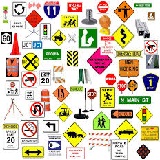 Drive America Drive America
Planning to drive in America? Learn the rules and
regulations. Great English reading practice. |
|